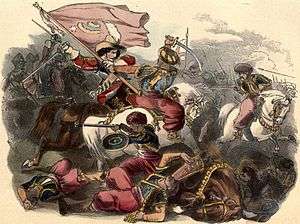Battle of Tangier (1664)
The Battle of Tangier or Battle of Jew's Hill took place on 4 May 1664 when a force of Moorish warriors ambushed and defeated a detachment of the garrison of English Tangier led by the Governor Andrew Rutherford, 1st Earl of Teviot, who was killed in the fighting. It was the heaviest defeat suffered by the garrison during the English possession of Tangier (1661–84).
| Battle of Tangier | |||||||
|---|---|---|---|---|---|---|---|
 Capture of a Moorish standard by the Tangier Horse | |||||||
| |||||||
| Belligerents | |||||||
|
| Moroccan forces | ||||||
| Commanders and leaders | |||||||
| Earl of Teviot (KIA) | Guyland | ||||||
| Strength | |||||||
| Around 500 | Around 11,000 | ||||||
| Casualties and losses | |||||||
| 470 | Unknown | ||||||
The Scottish-born Teviot was an active officer, who had implemented major reforms to the Tangier garrison since taking over as Governor the previous year. He had ordered the construction of new outlying fortresses to protect the town, and had enjoyed several victories over the forces of Guyland, a local leader.[1]
A major problem for Teviot was his lack of building materials. On 4 May he led out a large detachment of troops, a mixture of English and Irish soldiers, towards an area known as Jew's Hill (or Jew's Mount). It is generally believed that Teviot intended to gather stocks of stone, timber and other materials, although it has alternatively been suggested it may have been a foraging expedition or that Teviot indended to cut down some brushwood that Moorish forces had used as cover during their attacks on Tangier.[2]
Once Teviot had crossed Jew's River, he encountered around 3,000 Moroccan warriors. The English forces rapidly attacked and drove them off. They pursued the fleeing enemy, but it quickly became apparent that this was a trap as a much larger force was waiting to ambush them. The broken terrain was ill-suited for the British to form their battle ranks, and the engagement quickly descended into hand-to handing fighting in which the English were overwhelmed by sheer weight-of-numbers. Teviot attempted to rally his men on the top of Jew's Hill.
Only around thirty of the five hundred who had marched out escaped back to the safety of Tangier. As happened in other attacks by the Moroccans, the corpses of the English killed were mutilated.
Following Teviot's death, command devolved on his Irish Lieutenant Governor John Fitzgerald. Pressure on Tangier weakened due to political developments elsewhere in Morocco, and Fitzgerald agreed to a truce which by 1666 had become a general peace. Although occasional fighting continued, the town did not come under such sustained pressure again until the Great Siege of Tangier in 1680.
References
- Childs p.137-39
- Childs p.139-40
Bibliography
- Childs, John. The Army of Charles II. Routledge, 1976.
